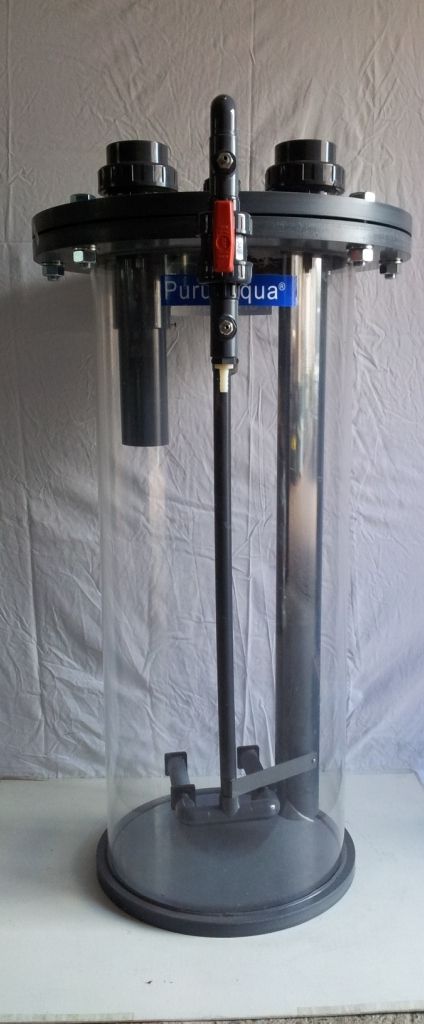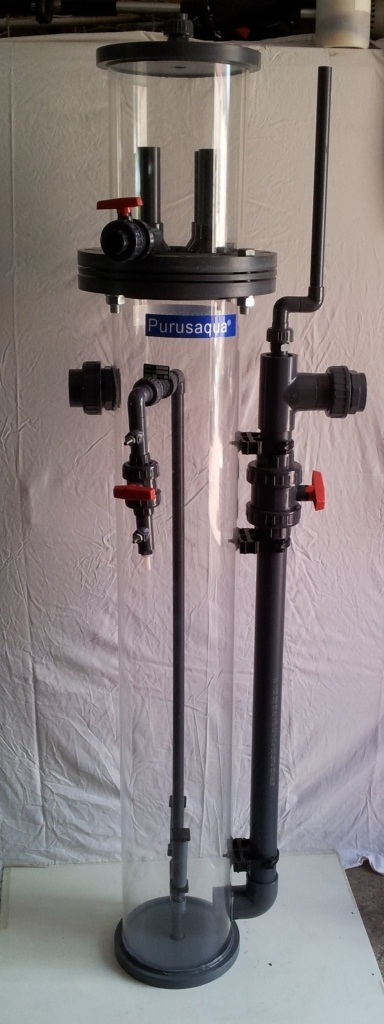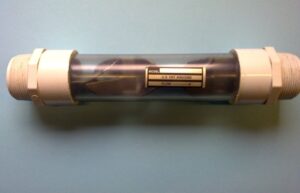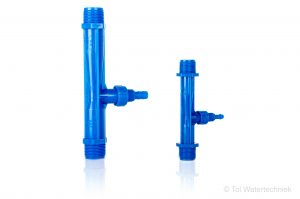On this page, you’ll find information on ozone reactors. The term ozone reactor is actually a collective name for all the products that are used to mix ozone into water. An ozone reactor is the most important part of an ozone installation; without a good reactor, the functioning will never be optimal.
The functioning of an ozone reactor
All ozone reactors work roughly the same way. A gas stream containing ozone is brought into the ozone reactor. This gas stream is intensively mixed water to give it a chance to react with the pollution. A good ozone reactor will therefore intensively mix the ozone with water to reach a long contact time. A couple thing increase the effectiveness of an ozone reactor:
- Small ozone bubbles (+/- 2mm, too small isn’t good either!)
- Mixing under high pressure
- Optimal water-ozone ratio
How big should the ozone bubbles be?
A popular statement is that the ozone bubbles should be as small as possible, mostly between 0,1mm up to 3mm. But ozone gas (every gas actually) has a hard time exchanging from the bubble into the water. The rate of speed at which the bubbles move through the water plays a big role here. Bubbles of 0,1mm barely move through the water column and therefore hardly exchange gas.
The optimal bubble size in normal reactors (skimmers, high pressure reactors) is around 2~2,5mm. This also depends on the flow through the reactor. If the bubbles are any smaller, they won’t rise up through the water and will be taken along with the water into the outlet of the reactor. And on bigger bubbles, the contact time will be too small.
If we take a look at venturis and static mixers, the bubbles can be smaller for optimal functioning because they will exit in the water anyways. Industrial systems can work with extremely small bubbles because the process parameters are way different (pressure and concentration). By changing the work pressure for example, it’s possible to achieve a good exchange with very small bubbles.
It’s a little too complicated to fully explain, but in a nutshell; the ozone bubbles never consist of ozone for 100%, the other part is air or oxygen. When the bubbles are extremely small, just the ozone on the edge of the bubble will be able to exchange into the water. The ozone in the middle isn’t able to move to the side, so only a small part of the ozone gets dissolved in the water.
When the bubbles are extremely small, the bubbles aren’t moving in the water which causes the exchange to be relatively low. This can be solved by forcing the gas to dissolve in the water.
As described above, mixing the ozone in is very important, but removing it is too. However, there are two ‘kinds’of ozone in water: free ozone and dissolved ozone.
Free ozone
Free ozone is the ozone that’s still in the gas bubbles in the water, these are visible. Free ozone should always be removed after the ozone reactor. If it’s not removed, these bubbles will escape out of the water whenever they can, for example in a pool or basin of a zoo. This can be noticed because of the ozone smell around the outlet. This is also called surplus ozone.
Dissolved ozone
What’s in the name definitely applies here, ozone can dissolve in water just like oxygen can. In some situations (mostly disinfection) it’s desired to have dissolved ozone in the water. That’s because the disinfection of surfaces and product relies on the fact that the dissolved ozone in the water will react with the pollution present when it comes into contact with it. That’s why we’d like to have as much dissolved ozone possible in the water in this situation.
In animal basins however, we would like to have little o no dissolved ozone because it will react with the things in the water. This can cause skin irritation for the animals in it. In pools, very small amounts, around 0,1 mg per litre are desired.
Let’s get back to disinfection with ozone, where lots of dissolved ozone is desirable. This is only possible when the ozone was generated with oxygen as a supply gas and is mixed in under high pressure. The ozone concentration in the gaseous phase also has to be high or otherwise it won’t be possible to get a high ozone concentration in the water.
Mixing ozone under high pressure isn’t without risk. The ozone treated water will be used as rinse water or something like that. When that happens, the pressure of the water will be atmospheric. Depending on the ozone concentration, the ozone will then degas from the water. This should definitely be taken into account in rooms where people or animals are also present because the ozone concentration can get dangerously high.
Skimmers
There are many kinds of ozone reactors, they each have their own function and corresponding advantages and disadvantages.
Protein skimmers
This type is often used in zoos and ponds. Skimmers originate from the ‘salt/seawater world’, which is where they are most effective as well. There’s little reason to use them in fresh water but they can still be spotted very frequently on ponds.
They perform okay as ozone reactors in fresh water, but don’t expect the results as when used in seawater. Skimmers have definitely proven their worth in zoos. However, those are way different than the skimmers usen on ponds. There are two kinds of skimmers, the gravity skimmer and the power skimmer.
Gravity skimmer
This is the well-known version used on ponds. The water is brought into the skimmer on top. Below are air stones that bring the ozone into the water. The bubbles rise through the water column until they leave the skimmer through the foam compartment.
Advantages:
- Low counter-pressure for the water pump (can even be fed by an air-lift)
- Skims protein at the same time
- Can be used to aerate the pond water at the same time
- De-gasses surplus ozone
Disadvantages:
- Big
- Expensive
- Efficiency is relatively low
- A lot of air is needed for a proper skimming function
- Has to be partially placed above the water level
Power skimmer
This is the most used version in zoos. The water is pushed through venturis using powerful pumps. The ozone is added in these venturis, after that, the water enters the skimmer where the bubbles rise to the foam compartment. This type of skimmer is much more effective thanks to the use of venturis. However, the energy consumption is also much higher.
Advantages:
- Efficient
- De-gasses surplus ozone
Disadvantages:
- Big
- Expensive
- High energy consumption
- Has to be partially placed above the water level
High pressure ozone reactors
The high pressure reactor is an ozone reactor where air stones are used to bring the ozone into the water. The ozone bubbles will rise up through the water column and get mixed in again when they reach the top. This is why a high pressure reactor has a high efficiency and still a low counter-pressure(1,5~2m).
This is the only ozone reactor that can de-gas and still be placed under the water level. It has the advantages of a power skimmer and a venturi, but not the disadvantages. This type is mostly used in ponds, pools and zoos and in the industry in smaller numbers.
Advantages:
- High efficiency
- Can be placed under the water level
- Needs little air to function well
- De-gasses surplus ozone
- Can also skim in some situations
Disadvantages:
- Relatively big
Static mixers
Static mixers have been used to mix in ozone for a couple years now. This method for mixing gasses and fluids has been around in the industry for much longer though. The mixer on the picture is one of the few static mixers that do work and is therefore the only mixer we apply for industrial purposes.
A good static mixer makes the bubbles smaller. However, most mixers out there only spin them around and do nothing to decrease their size. These mixers have a very low efficiency. Please inform yourself on mixers before buying one. Besides that, you do need to think about a way to de-gas the ozone when using a static mixer because it doesn’t do that for you.
Advantages:
- Fairly compact
- Needs little air to function well
Disadvantages:
- Very high counter-pressure if you wish for a high efficiency
- Something will have to be arranged to de-gas the surplus ozone.
- A good mixer is expensive
Venturis
A venturi is still one of the most used products to mix ozone with water in industrial systems because it has the highest efficiency. However, a high pressure drop across the venturi is needed for it to work properly. Powerful pumps will have to be used to achieve this, which is the biggest disadvantage.
Advantages:
Disadvantages:
- Very high counter-pressure when you want a good efficiency
- Something will have to be arranged to de-gas the surplus ozone
What ozone reactor is best for me? .
It fully depends on the situation what ozone generator is best suited for your application.
Ponds
A couple ozone reactors can be used on ponds. The gravity skimmer, high pressure ozone reactor and static mixer are the most commonly used options. A high pressure ozone reactor or gravity skimmer are the most preferable ones. Both are simple to use, have low operating costs and have a high enough efficiency for this application.
Private pool
Venturis are the most used option on private pools. This is just fine but the system does need to be built correctly. Dissolved ozone should never end up in the pool itself, which is a realistic risk when a venturi is used.
A de-gas vessel should be present after the venturi when a venturi is used. In some cases, the oozne is injected in a sand filter. This is also a good option, but do keep in mind the sand filter should be ozone resistant! Polyester de-laminates at ozone concentrations higher than 2% for example (weight percentages).
Public pools and theme parks
The same methods as the ones for private pools can be applied to public pools. On bigger pools and water attractions in theme parks, it’s usually cheaper to purchase a high pressure reactor because this already has a de-gas option.
Zoos
The best option in a zoo depends on the water in the basin. High pressure ozone reactors are mostly used on fresh water basins, optionally combined with a venturi or a static mixer. It can be interesting to use a power skimmer when there’s a lot of organic pollution, this is capable of removing small organic pollution in fresh water as well.
Power skimmers are almost always the best option in salt water basins because this is where they can reach their full potential. Despite the high power consumption, this still remains the best choice.
Industry
The most used option in the industry is the venturi, especially when high ozone concentrations are required. A high pressure ozone reactor can be an interesting alternative for les demanding applications.
© Tol Watertechniek



